Hand therapy
What is a metacarpal hand fracture?
This hand fracture is a break through the bone in the hand known as the metacarpal. The level of the break along the metacarpal depends on the how the injury happened and the different levels are shown in the picture below.
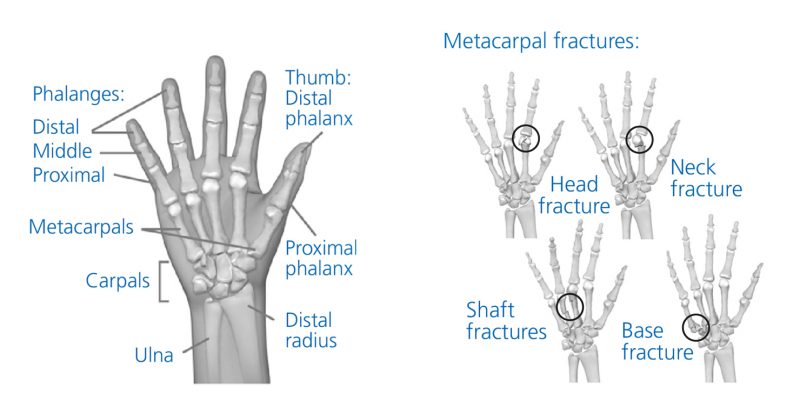
A metacarpal fracture can happen in a variety of ways including a fall on an outstretched hand, a crushing injury, or hitting an object with a clenched fist. There is usually immediate pain and swelling in the hand. You may also see that the hand is deformed. It is common to see a bump over the back of the hand where the fracture is located.
Why is it important to protect the break whilst healing?
Neck and shaft metacarpal fractures can be protected by strapping the fractured finger to the finger next to it. This provides a splint to help protect the healing bone from too much strain, but will also allow early movement.
This strapping is known as buddy strapping, and is needed for three weeks from the day of injury. During this time the hand should only be used for light tasks. Even when the strapping is removed the bone will not be strong enough for heavy work or non-contact sports until at least six weeks.
Contact sports, in particular boxing, should be avoided until at least 12 weeks after injury. Sometimes these estimated times will take longer if pain and poor movement continues.
Occasionally base and shaft metacarpal fractures may require a cast to be applied to your hand. This is usually kept in place for three weeks, but the fingers will be kept free to allow for early movement.
How do I buddy strap?
You will be shown the correct way to strap your fingers in clinic.
A small piece of gauze goes between the fingers, which are then taped together at the top and bottom with care not to tape across any of the finger joints so movement is not blocked. This strapping can be changed by you every second day to allow you to clean your hand and care for your skin.
Why does my injured hand swell?
Swelling is an important part of the healing process, but too much swelling causes problems such as pain and loss of finger movement. To help control swelling you must try and keep your hand raised at the level of your chest, and not have it resting by your side for a long time.
You may be given double layered tubi-grip to wear, which is a type of compression bandage aimed at helping to reduce your swelling. This can be worn throughout the day but must be taken off over night. You can also try a cold compress on the hand for 10 minutes three to four times a day in the first few days follow injury.
It can take many months for all of the swelling to completely settle in the hand.
Why is it important to exercise?
There are many important structures that lie very close to your hand fracture. These include the tendons which straighten and bend your finger. If you do not move your finger these tendons can stick to the healing bone and reduce finger movement. This may make certain activities difficult such as strong gripping.
The exercises that follow will help the tendons to glide over the fracture and achieve the best possible results.
Exercises
Some or all of the following exercises will be demonstrated. Keep your wrist straight throughout and repeat each one 5 to 10 times.
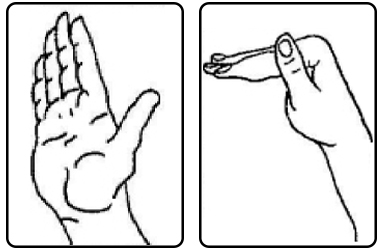
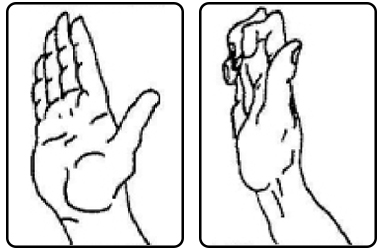
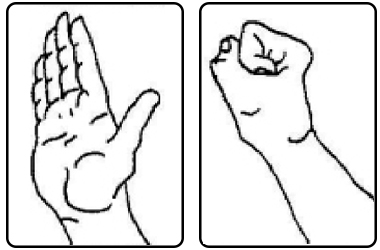
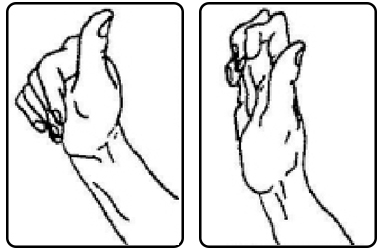
When to call for advice?
If you have problems following your exercises, contact the hand therapy team on
T: 01642 835595
E: [email protected]
If you are very concerned with pain and discomfort in your finger, contact your consultant’s secretary.
Patient experience
South Tees Hospitals NHS Foundation Trust would like your feedback. If you wish to share your experience about your care and treatment or on behalf of a patient, please contact The Patient Experience Department who will advise you on how best to do this.
This service is based at The James Cook University Hospital but also covers the Friarage Hospital in Northallerton, our community hospitals and community health services.
To ensure we meet your communication needs please inform the Patient Experience Department of any special requirements, for example; braille or large print.
T: 01642 835964
E: [email protected]